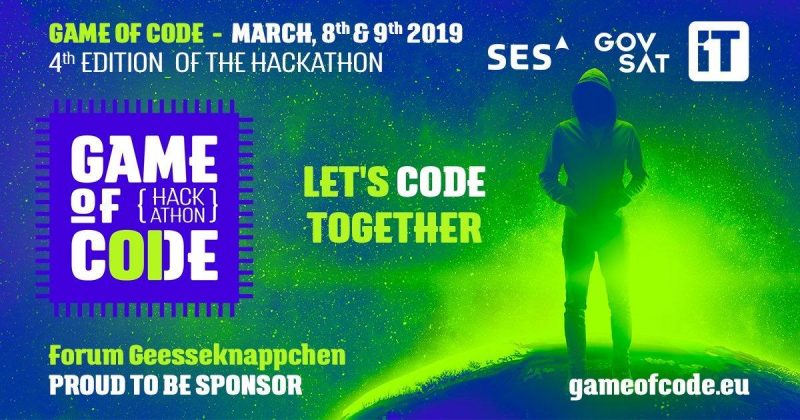
Callout to cybersecurity experts, coders, designers and even coaches/mentors! Let’s meet on March 8-9, 2019 for 24hrs of coding (gameofcode.eu)
GovSat/SES, in collaboration with SECURITYMADEIN.LU, are proud
to announce that this year – and for the first time – there will be a
challenge related to cybersecurity and space.
Information security is of everybody’s concern and we bet yours too, so
are you willing to take this challenge and try to revolutionize
satellite and or cybersecurity industries? Here is the plot:
For the 2019 edition of Game of Code, GovSat and SES have developed a
fictive use case of an imaginary company called ACME Sat. ACME Sat is
satcom provider that offers managed satcom services to customers
worldwide and is committed to provide best in class secure satellite
communications therefore cyber security is one of their top priorities.
In their continuous effort to enhance information security, they have
setup the following challenge to coders and cyber security enthusiasts.
Your role
You will act as strategic advisor and integrator for the information security department of ACME Sat.
Your mission
Assess today’s satellite communication principles, especially in the
information security context, and design and implement a solution that
brings improvements to this ecosystem. Focusing on all components of
satellite delivered services: cyber security, access control in unmanned
locations, social engineering etc. is what ACME Sat is mostly
interested.
The environment
Consider a classical satellite communication ecosystem which includes
end-users as systems but most importantly as humans, satellite terminals
(antennas), radio-frequency links, satellite itself, access to public
terrestrial infrastructure and so on.
Your tools
There are no restrictions on technologies, platforms, programming
language. You are free to define the scenario, but keep in mind the
quality of the proposed scenario will also be evaluated.
—
We understand is vast, but so are the space and cybersecurity
businesses. ACME Sat is just a classical example of a satcom provider so
don’t panic, our teams will work alongside with you to shape ideas and
guide you through satcom service architecture. In fact, we have some
samples/ideas already here, check them out:
- Sample 1: Service integrity validation using blockchain
Managed
satcom services are complex and during their lifetime go through many
changes such as: component replacements, satellite capacity
upgrades/downgrades, supporting personnel turnover or data hosting
migration from local hosting to cloud, just to name a few.
The challenge is to build a software application that uses blockchain
for validating the integrity of a managed service throughout its entire
lifetime regardless of the changes it might suffer.
Why? ACME Sat wants to help its customers in many ways: raise awareness
about service modifications, detect unauthorized changes, verify the
sanity of the components replaced or get a history of their service
evolution.
- Sample 2: Social Engineering Awareness
How
about building an application/program that displays the
digital/internet footprint of an entry (person name, company name,
domain name, email address, telephone number etc.) and matches to the
other of another entry.
Why? We want to bring awareness on the digital noise we leave behind us
while browsing, using apps, social media and try find the source of
information for those nasty targeted social engineering activities (e.g.
targeted emails, phone calls etc.). We are all annoyed by them, to say
the least so let’s turn this pain in a creative business opportunity!!!
- Sample 3: Access Control System
Build
software application that simulates a two-factor authentication access
control system. What the application is going to open is a world of
opportunities, but for the moment the authentication itself is of
interest.
Why? The goal is to raise awareness on authentication systems and build
the enhanced security systems of the future. There are some limitations:
factors must be different and usage of knowledge factor (memorized
passwords, PINs etc.) is not allowed. Would be too mainstream, right?
However, there is plenty left to use: possession factor (exp. Token),
biometric factor (iris, fingerprint, face), location factor (geolocation
during the authentication attempt) or time factor (time of the
attempt).
